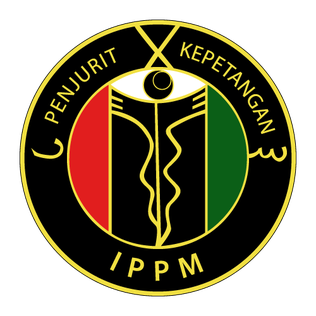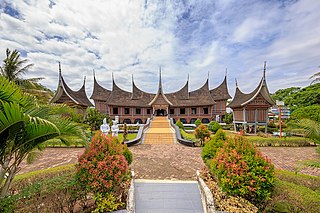Related Research Articles

Malay is an Austronesian language that is an official language of Brunei, Indonesia, Malaysia, and Singapore, and that is also spoken in East Timor and parts of Thailand. Altogether, it is spoken by 290 million people across Maritime Southeast Asia.

Minangkabau people, also known as Minang, are an Austronesian ethnic group native to the Minangkabau Highlands of West Sumatra, Indonesia. The Minangkabau's West Sumatran homelands was the seat of the Pagaruyung Kingdom, believed by early historians to have been the cradle of the Malay race, and the location of the Padri War.

West Sumatra is a province of Indonesia. It is on the west coast of the island of Sumatra and includes the Mentawai Islands off that coast. West Sumatra borders the Indian Ocean to the west, as well as the provinces of North Sumatra to the north, Riau to the northeast, Jambi to the southeast, and Bengkulu to the south. The province has an area of 42,119.54 km2 (16,262.45 sq mi), with a population of 5,534,472 at the 2020 census. The official estimate at mid 2022 was 5,640,629. The province is subdivided into twelve regencies and seven cities. It has relatively more cities than other provinces outside Java, although several of them are relatively low in population compared with cities elsewhere in Indonesia. Padang is the province's capital and largest city.

Rendang is a Minangkabau dish. It is a rich dish of meat that has been slow cooked and braised in a coconut milk seasoned with a herb and spice mixture over a period of several hours until the liquids evaporate and the meat turns dark brown and tender, becoming caramelized and infused with rich flavours.

Pagaruyung, also known as Pagarruyung, Pagar Ruyung and, Malayapura or Malayupura, was a kingdom that once stood in the island of Sumatra and the seat of the Minangkabau kings of Western Sumatra. Modern Pagaruyung is a village in Tanjung Emas subdistrict, Tanah Datar regency, located near the town of Batusangkar, Indonesia.

Adityawarman was a king of Malayapura Suvarnabhumi, and is the successor of the Mauli dynasty based on central Sumatra. He was the cousin of Jayanegara, king of Majapahit from 1309 to 1328, and the grandson of Tribhuwanaraja, king of Melayu Kingdom. Adityawarman was awarded the Senior Minister of Majapahit (wreddamantri) and used this authority to launch Majapahit military expansion plans and conquered east coast region in Sumatra. Adityawarman then founded the royal dynasty of Minangkabau in Pagaruyung and presided over the central Sumatra region to take control of the gold trade between 1347 and 1375.

The Melayu Kingdom was a classical Buddhist kingdom located in what is now the Indonesian province of Jambi in Sumatra.
Ananggawarman was a crown prince (yuvaraja) of the Malayapura kingdom, which ruled at the end of the 14th century. The Malayapura kingdom was centered on the Minangkabau Highlands and its territory covers much of central Sumatra. The name Ananggawarman is inscribed on Saruaso II inscription as the son of King Adityawarman. It is not clear when Ananggawarman began to reign in place of his father, but it was written in the History of Ming that the kingdom sent a messenger again to China in 1376.

Malay Indonesians are ethnic Malays living throughout Indonesia. They are one of the indigenous peoples of the country. Indonesian, the national language of Indonesia, is a standardized form of Riau Malay. There were numerous kingdoms associated with the Indonesian Malays along with other ethnicities in what is now Indonesia, mainly on the islands of Borneo and Sumatra. These included Srivijaya, the Melayu Kingdom, Dharmasraya, the Sultanate of Deli, the Sultanate of Siak Sri Indrapura, the Riau-Lingga Sultanate, the Sultanate of Bulungan, Pontianak Sultanate, and the Sultanate of Sambas. The 2010 census states that there are 8 million Malays in Indonesia; this number comes from the classification of Malays in East Sumatra and the coast of Kalimantan which is recognized by the Indonesian government. This classification is different from the Malaysia and Singapore census which includes all ethnic Muslims from the Indonesian archipelago as Malays.

The Padang Roco Inscription, in Indonesian Prasasti Padang Roco, is an inscription dated 1286 CE, discovered near the source of Batanghari river, Padangroco temple complex, Nagari Siguntur, Sitiung, Dharmasraya Regency, West Sumatra, Indonesia.

Istiadat Pewaris Penjurit-Kepetangan Melayu or formerly known as Ilmu Persilatan Penjurit-Kepetangan Melayu, shortform IPPM is one of the oldest original known to date Malay martial art form or called 'Silat' in existence which has been heritage from one generation to another. Descended from the first ruler of the Malayapura Kingdom, King Adityawarman whom is also known as Seri Maharaja Diraja which to a later stage sparked the start of Minangkabau history in Pagaruyung Kingdom, Sumatra, Indonesia. These story has been greatly narrated in most of old Malay Literature including in of the most reliable sources to date called Sulalatus al-Salatin or better known as The Malay Annals (Malay: Sejarah Melayu). The manuscript begin with the stories of Wan Malini and Wan Empuk whom was presented with 3 adopted princes right after when their rice fields was magically expelling gold. These 3 princes was later mark as the kickstart for the next 3 big empires in Malay Archipelago. Those empires were the Kingdom of Majapahit, The Malacca Sultanate and the Pagaruyung Kingdom around the 12th century.
Dara Jingga, was one of the Malay Dharmasraya princess who was intended to be betrothed to Javanese King Kertanegara of Singasari after the Pamalayu expedition 1275–1293.

Adityawarman Museum is a State Museum located in Padang, Western Sumatra. As a State Museum, Adityawarman Museum is officially known as the State Museum of West Sumatra. The museum displays ethnographic collections of items related to the culture of the Province of West Sumatra, particularly the culture of Minangkabau and Mentawai.
Adwayawarman was the father of King Adityawarman of Malayapura kingdom as mentioned in the Kuburajo I Inscription. His alias name was Adwayadwaja, as he was called in the Bukit Gombak Inscription.
Bijayendrawarman was the name of one a yuwaraja of the Malayapura kingdom, who ruled in the 14th century in the Pasaman Regency, West Sumatra, Indonesia. Bijayendrawarman's name is written in Lubuk Layang inscription, found in Pancahan village, in Rao Selatan district of Pasaman. It was stated that he built a stupa, in a place called Parwatapuri.
Akarendrawarman was a ruler of Malayapura kingdom in the Minangkabau plateau. His name was found in the Pagaruyung VII inscription, which is written in Old Malay, his full title is Paduka Sri Maharajadhiraja Srimat Sri Akarendrawarman. In carrying out his administration, he was assisted by various other officials, among others was a minister called Tuhan (lord) Parpatih. The kingdom was mentioned to be located in Parhyangan on Mount Mahameru.

Sri Maharaja Srimat Tribhuwanaraja Mauliwarmadewa was a king of Dharmasraya in Bhumi Malayu (Sumatra), as written on the Padang Roco inscription (1286).

Saruaso II inscription, also previously known as Batusangkar inscription, is one of the inscriptions from the King Adityawarman era. It is currently located at the Fort van der Capellen area, in the courtyard of the old office of the Monuments Preservation Department, in Batusangkar city, West Sumatra, Indonesia. The inscription was previously displayed across in front of the Indo Jalito Building, which was the residence of the Regent of Tanah Datar during the Dutch colonial period. The inscription is written in Old Javanese script and Sanskrit language.

Kuburajo Inscription, also called Kuburajo I Inscription, is one of the many inscriptions left by King Adityawarman of central Sumatra. The inscription was found in Kuburajo village, Lima Kaum district, Tanah Datar Regency, West Sumatra, Indonesia in 1877 besides the main road from Batusangkar city to Padang city. The inscription was registered by N.J. Krom in Inventaris der Oudheden in de Padangsche Bovenlanden. The inscription is written in Sanskrit, and consists of 16 lines. This inscription was lost in 1987, but was rediscovered.
The Kerajaan Jambu Lipo or Kingdom of Jambu Lipo is located in the district of Lubuk Tarok, Sijunjung district, West Sumatra now. According to Tambo Minangkabau, the name Jambu Lipo came from the result of an agreement between Rajo Tigo Selo in Pagaruyung which should not forget each other, with the origin of the word "jan bu lupo" which means "don't forget mother".
References
- 1 2 Abidin, Mas'oed (2005). Ensiklopedi Minangkabau (in Indonesian). Pusat Pengkajian Islam dan Minangkabau. p. 90. ISBN 978-979-3797-23-6.
- 1 2 3 4 5 Kozok, Uli (2015). A 14th Century Malay Code of Laws: The Nitisarasamuccaya. Vol. 16 dari Nalanda-Sriwijaya Series. Institute of Southeast Asian Studies. pp. 39, 325–326. ISBN 978-981-4459-74-7.
- 1 2 3 Chandra, Dodi (25 September 2013). "Prasasti Lubuk Layang, Pasaman" (in Indonesian). Minangkabau Arkeologia. Retrieved 2 September 2016.
- 1 2 Bunga rampai pengetahuan adat Minangkabau (in Indonesian). Padang: Yayasan Sako Batuah. 2000. p. 172.
- ↑ Kozok, Uli (2016). 14th Century Malay Code of Laws:: The Nitisarasamuccaya . Flipside Digital Content Company Inc. ISBN 981-4620-49-1, 9789814620499.